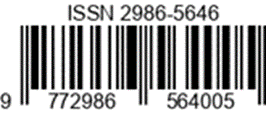The Form of Presentation of Sempaya Dance in Gamad Art at A Wedding Party in Ujung Padang Village
DOI:
https://doi.org/10.24036/ag.v1i3.32Keywords:
learning, arts and culture, musicAbstract
This study aims to describe the presentation form of Sempaya Dance in Gamad Art at the Marriage Party in Ujung Padang Village, Kota Mukomuko District, Mukomuko Regency. This type of research is qualitative with descriptive analysis method. The instrument used is the researcher himself by using tools such as cellphones, digital cameras and stationery. Data collection techniques are done by means of literature study, observation, interviews, documentation. The steps of analyzing data are data collection, data reduction, data presentation and conclusion drawing. The results showed that Sempaya Dance is one of the traditional dances that becomes an icon and culture in Mukomuko Regency with a representational symbolic presentation form and functions as a means of custom and entertainment. The elements of the Sempaya Dance presentation form are as follows: (1) Consists of Opening Movement, Core Movement, Closing Movement, (2) Using 4 floor designs: horizontal, large circle, small circle, and square, (3) Traditional music ketipuang (drum), Kecaping (harp), (4) Makeup (beautiful) costumes of kebaya clothes, skirts and veils (5) Dancers must be even cannot be odd because this dance is in pairs, (6) Dance property is handkerchief (7) Place of performance in front of the aisle and can also be on stage.
References
Armi, R. F., & Mansyur, H. (2022). Bentuk Penyajian Tari Hari Langsung Sebagai Tari Kreasi Masyarakat Kota Pekanbaru. Jurnal Sendratasik, 11(2), 219-226.
Eka Norhayani, N., & Eny Iryanti, V. ( 2018). Bentuk dan Fungsi tari Jenang Desa Kaliputu Kabupaten Kudus. Jurnal Seni Tari 7 (1), 49-57.
Hasanah, F. A., Mansyur, H., & Asriati, A. (2018). Bentuk Penyajian Tari Putri Berhias Di Kota Lubuklinggau. Jurnal Sendratasik, 7(1), 1-5.
Indrayuda. (2013). Tari Sebagai Budaya dan Pengetahuan. Padang: UNP Press.
Nazir, Moh. Ph. D. (2009). Metode Penelitian. Jakarta: Ghalia Indonesia.
Putri, N., & Darmawati, D. (2023). Bentuk Tari Payung Sarampak di Sanggar Lindang Urek Kecamatan Payakumbuh Timur, Kota Payakumbuh. AVANT-GARDE: Jurnal Ilmiah Pendidikan Seni Pertunjukan, 1(2), 177–185.
Sedyawati, Edi. (1981). Pertunbuhan Seni Pertunjukan. Jakarta: Sinar Harapan.
Smith, Jacqueline. (1985). Komposisi Tari: Sebuah Petul1juk Praktis bagi. Guru (terj. Ben Suharto). Yogyakarta: IKALASTI.
Soedarsono, F.X. (1997). Pedoman Pelaksanaan Penelitian Tindakan. Kelas Buku II. Yogyakarta: IKIP Yogyakarta.
Sugiyono (2011). Metode Penelitian Kuntitatif Kualitatif dan R&D. Bandung: Alfabeta.
Susetyo, Bagus. (2009). Kajian Seni Pertunjukan. Handout. Semarang: Unnes Press.
Triagnesti, S., & Mansyur, H. (2021). Bentuk Penyajian Tari Pisau Dua Pada Acara Bimbang Adat Di Desa Sendawar Bengkulu. Jurnal Sendratasik, 10(3), 80-89.
Downloads
Published
Issue
Section
License
Copyright (c) 2023 Laily Wulan Rahmawati, Herlinda Mansyur

This work is licensed under a Creative Commons Attribution-NonCommercial-ShareAlike 4.0 International License.











